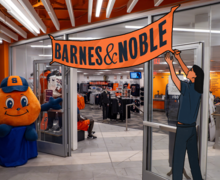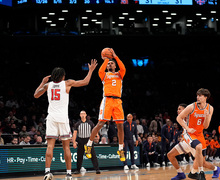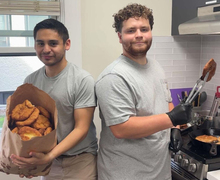Overdue funds: Long-awaited campaign addresses library needs
State of the library: Part 2 of 3
Plans to expand E.S. Bird library into Walnut Park fell through 10 years ago. Plans failed again five years later after librarians and designers tried to re-organize the interior of the building. This year, the library stalled another renovation project.
‘This isn’t the first time the library has been neglected,’ said Lesley Pease, head of the Syracuse University Learning Commons. ‘Before this we did the ‘Master Plan,’ and the previous head of the library had the ‘Big Bird’ plan.
‘We were going to get the money and then we weren’t. Maybe we don’t yell enough. I don’t know,’ Pease said.
SU’s Bird Library undertook a fundraising campaign with a goal of $18 million by 2012 to fund overdue improvements to the library. The money raised will go toward building renovations and broadening research resources that will suit the needs of students and faculty, said David Murray, assistant dean for advancement of the library.
Since fundraising began about a year ago, the library has raised between $1 million and $2 million. The library is just beginning to fundraise in earnest, Murray said.
SU funds 99 percent of the library’s $16 million yearly budget. Currently, about 1 percent comes from outside donations.
‘Every dollar they spend here they can’t spend on financial aid or building dorms, and there are a lot of buildings in worse shape than us that need renovations,’ Murray said. ‘But the library should be much better.’
Because of the urgency of improving the library, the library’s administration hopes to raise money that can be used immediately, rather than through endowments, Murray said.
Before Bird was built, the original plan for SU’s library was to have three separate buildings: one for graduate students and faculty research, one for interactive and collaborative work, and one for special treasures, ancient books and historical artifacts, Murray said.
‘We have to do all three of those things now in one building,’ he said.
To improve Bird’s academic facilities, a portion of money raised in the past year was donated to build classrooms on the basement floor, but the plans were not followed through, Murray said.
The library administration decided to stall plans after graduate students and faculty complained about moving resources to an off-campus facility four hours away in Paterson, N.Y. Part of the concern was the library giving space to things other than books and scholarly research materials, Murray said.
Of the $18 million the library hopes to raise, $7 million will go to projects that will help students academically, such as updating the lower-level learning commons where students can work on group projects, as well as buying computers and specialized technology like video-editing software, Murray said.
The building updates would establish the lower three floors as learning commons and the upper floors for resources and quiet research space, Murray said.
‘We are chronically underfunded,’ Pease said about research materials. ‘Librarians are constantly meeting with faculty and students to find out what can be cut.’
Lack of funds has also kept the library from going forward with attempts to provide large color printers that staff intended to buy several years ago for the first-floor computers, Pease said.
While more technology such as computers and software is needed, it is easy to find inexpensive deals. But the improvement requested the most by students and faculty is more electrical outlets, which are incredibly expensive to install in a concrete building like Bird, Pease said.
At one point, library administrators and contracted designers discussed installing a faux-floor above the concrete to place more outlets, Murray said. The $5 million it would cost to install outlets throughout the library is something the current university budget cannot finance, he said.
Murray understands that the university needs to prioritize where it gives funding, and the library may not be the most important thing, he said.
Alyssa Henry, a senior broadcast journalism major, echoed Murray’s sentiment. Though Henry usually uses the library during midterms and finals weeks, she said the university should improve the facility for student work throughout the semester.
‘You’d think that having place where students can go to learn would be one of their top priorities,’ Henry said.
Henry thinks that SU’s individual colleges could allocate more funds to the library by cutting back on less-important and less-utilized projects, such as the Connective Corridor, she said.
But Murray thinks the fundraising campaign is gaining traction, he said. The library has already hosted campaign events for alumni in 10 major cities and is reaching out by mail to potential donors.
One of the hardest things about fundraising is showing how the library makes a difference, Murray said. Having never worked at a library before taking the position at Bird, Murray didn’t know if a library could change anybody’s life, he said.
‘I realized that we really do make a difference,’ Murray said. I’ve had students come to me saying I wouldn’t have finished my dissertation or finished my term paper without the library.’
Published on March 1, 2010 at 12:00 pm





